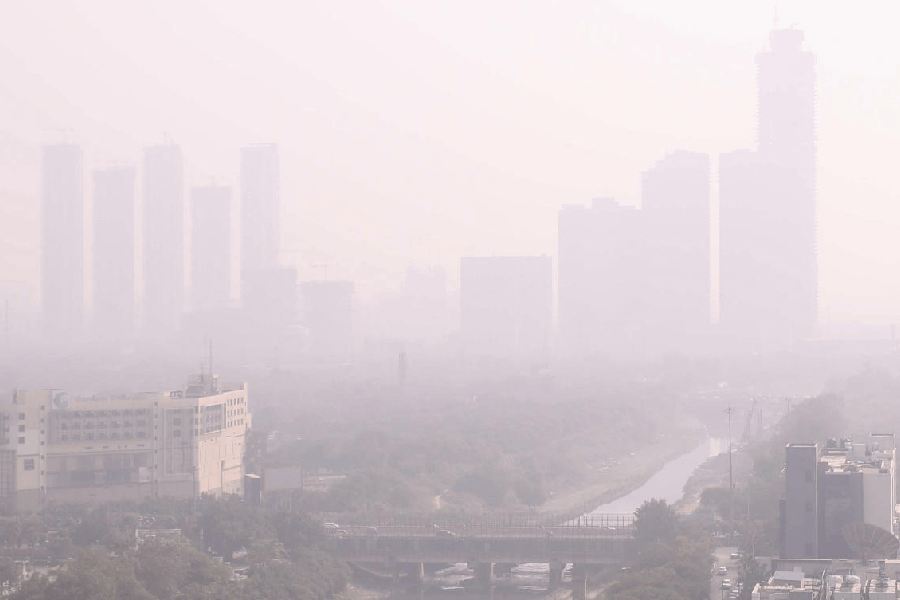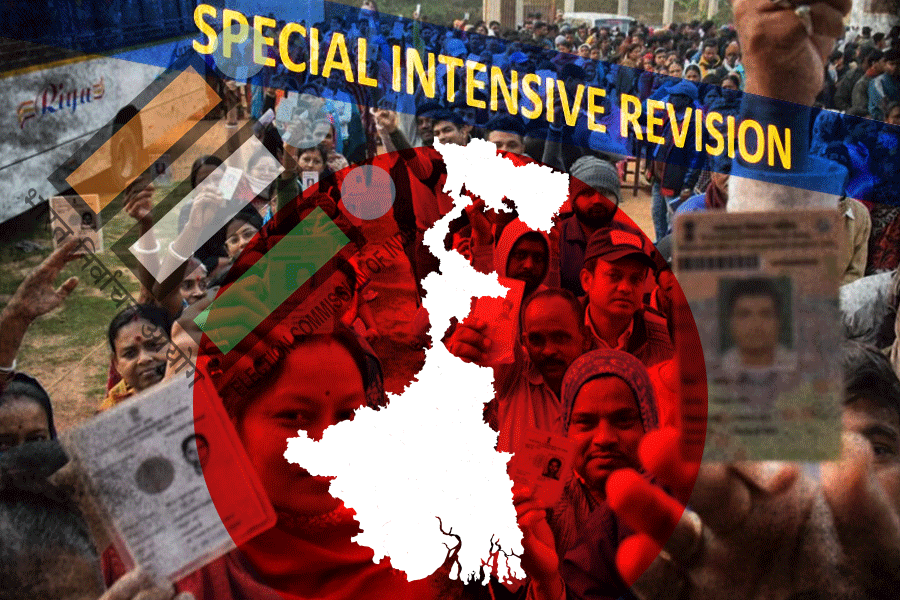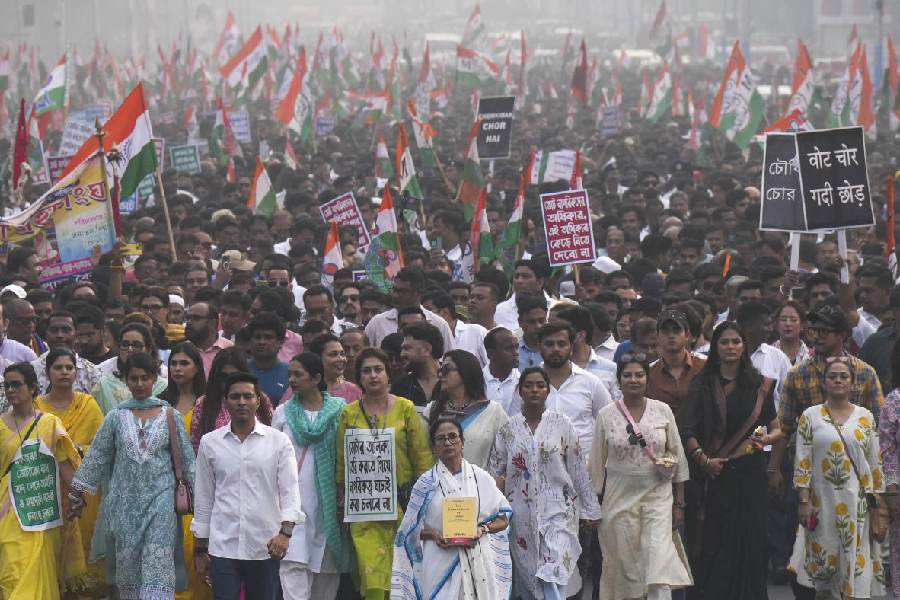|
|
Recounting memories of early childhood to her daughter, Indira Debi, Jnanadanandini Debi, wife of Satyendranath Tagore, first Indian member of the Indian Civil Service, remembered being allowed to sit in the pathshala run in her father’s home together with the other students — all boys. She was very young indeed — perhaps only five at the time. By 1859, when she was all of seven, she was a bride in the large and intimidating Tagore household. When she was older, Jnanadanandini’s husband took care in working towards a companionate marriage and introduced his wife to travel and the world beyond the home.
Satyendranath Tagore had sought his father’s permission to send his wife for a stay in England on her own. Much later, Jnanadanandini commented that “my husband probably sent me so that I would acquire some of the manners and customs of the British; he was a great admirer of theirs”. Though he did visit the family during their two-and-a-half years stay abroad, Jnanadanandini coped alone — even with the anguish of losing a child. Earlier, she had lived with Satyendranath on his postings in western India, mixing freely with Parsi and Gujarati families.
On returning from England, Jnanadanandini decided to move to Calcutta and set up a household separate from that of the large Tagore family establishment at Jorasanko. A bold step indeed — but then she was an amazing woman who made full use of the opportunities at hand. Her home became a favourite haunt of Rabindranath’s and it was from here that his child-bride, Mrinalini, was schooled at the nearby Loreto Convent and trained in various other social and housewifely skills by her much older, sophisticated sister-in-law.
The ideal of the middle-class companionate wife who was equipped to react to changing expectations emerged by the mid-decades of the 19th century. It was also at around this time that middle-class initiatives in establishing girls’ schools in the three Presidency towns were formalized. The roots lay in missionary endeavours that resulted in the first girls’ schools in Bengal, and in south India, the Church Missionary Society boarding school for girls was set up in 1821 in Tirunelveli. However, in Bengal, as it was difficult to get girls from the upper castes to these schools, the zenana or home tuition project gained popularity and allowed missionary women and governesses entry into households to teach the three Rs, needlework, basic hygiene, and to read stories to girls and young women. Fathers, brothers and other men in the family also filled in as informal tutors.
Jnanadanandini Debi may not have had much by way of formal education, but she made good use of her tuition through the zenana system. She not only knew enough to write letters to magazines but also edited the family’s children’s magazine, Balak, and learned how to handle the camera. The authority on 19th-century photography in Bengal, the late Siddhartha Ghosh concluded that given the strictures of purdah society, it is likely that some of the available photographs of her mother-in-law, Sharada Debi and other women in that generation were taken by Jnanadanandini. The younger women would have probably visited studios. Together with other relatives, Jnanadanandini was instrumental in bringing about innovative changes in girls’ and women’s dress, some of which combined elements of Western sartorial style with the sari as worn by the Parsis. Such innovations were essential for a heightened female visibility both within and outside the home, and indeed for girls being equipped for school. In her crusade for dress reform, Jnanadanandini offered to help out those who may have difficulty in envisaging what the new outfit looked like. She volunteered to send a picture (chhobi) and though the term could mean a painting as well as photograph, it is likely that she had in mind the latter.
By the middle of the 19th century, middle-class urban Indians grew aware of the need to take an initiative in girls’ schooling and started working towards setting up appropriate institutions. Sometimes, as in the case of Bethune School in Calcutta, these were in active collaboration with the British. While from the 1890s onwards, there are a few interesting studio photographs of girls in school uniforms, two of the earliest non-missionary efforts chose to have a photographer and his entourage come to the schools.
The 1873 photograph here within a classroom of Alexandra Native Girls’ English Institution in Bombay was, in all likelihood, taken by the staff of Bourne and Shepherd studio. In 1863, with subscriptions and a grant of land from the government, Manockjee Cursetjee had set up the English medium school and it was the first of its kind in Bombay to provide a liberal education for Indian girls — but it was mostly Parsis who attended it. Bhikaiji Patel (later Madame Cama) is perhaps the school’s most famous alumnus. It continues to this day in the city, though in different premises.
The photograph shows the girls dressed in elaborate Parsi-border saris, or garas. These were either originals or based on the all-over hand-embroidered silk garas brought back by Parsi traders from China in the 1850s. Under the sari pallav is the mathubanu that loosely binds the head. The girls seem to be of all ages — the younger ones wear jackets and topees over skirts — and are likely to have been from more than one class. It is possible that they were especially dressed for the occasion. They all look in the direction of their teacher, who is rotating the globe, though the downcast eyes of a couple are unmistakable. Possibly, the glare of lights and the long duration of the entire process had tired them.
In the same year that this photograph was taken, collaborating with the visiting Unitarian, Annette Akroyd in Calcutta, the Brahmos, Sivanath Sastri, Dwarakanath Ganguly, Monomohan Ghose and others set up the Hindu Mahila Vidyalaya with 14 students. This was a couple of decades after the Calcutta Female School (later known as Bethune School) had been in existence. Marking a break with the dominant discourse that believed in less taxing curricula for girls, the new school provided the same kind of learning for its students as was available for boys. Annette supervised the teaching and taught her students how to eat at table with cutlery while Dwarakanath not only took on the organization of the school and its successor, the Banga Mahila Vidyalaya, but also wrote alternative textbooks in mathematics, geography and health science.
Arithmetic, history, the rudiments of the physical sciences as well as domestic economy were taught to daughters of the Brahmo elite who were expected to wear Western dress. With the establishment of the dressmakers, Basu and Company, in Calcutta, girls could now wear a gown, skirt and blouse. It is interesting that the Bengali establishment skillfully replicated styles in vogue among the colonial population. A photograph of students with Annette outside the school bungalow shows older girls in saris and long-sleeved blouses, while the younger ones are in skirts. One teacher even wore a flounced dress with jabots and frills at different levels of the skirts — a true reflection of European styles of the time. It is not difficult to imagine the discomfort of wearing such clothing — given the hot and humid climate of Calcutta. In order to maintain the requirements of a purdah society, girls came to school in horse-drawn carriages with curtains — a practice that was continued for some years even when buses were introduced.
What is significant about both photographs is that they are situated in the school premises with the students posing patiently; there is little doubt that both were taken with a specific purpose in mind. At one level, they would serve as memorabilia for students and their families; at another more serious one, the photographs would remind its many detractors that girls’ education, whether through the zenana system or through the growing number of schools, had come to stay. Nor could the implication of girls viewing the world beyond through the globe be overlooked. Visualization added an important element to knowing — and it may be fair to surmise that the composition of the photograph was in no way innocent or accidental.











